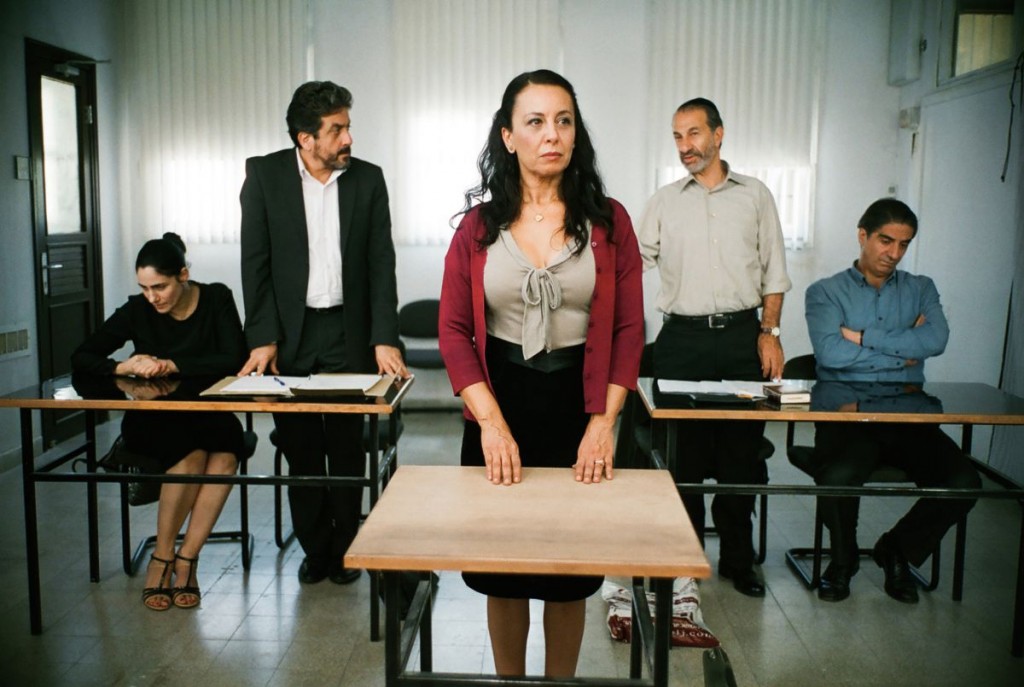Paul N., Here…
When a director makes the conscious choice to set his or her film within the confines of a single location, they make the conscious choice to sacrifice certain key elements of cinema. It’s a high risk, high reward choice that has left more than a few filmmakers burned. A lack of setting and plot must be replaced with compelling conflict and character. The audience has no stimulation for the eye, so the imagination must be entertained with vivid description and compelling acting.
Gett: The Trial of Viviane Amsalem tells the tale of an Israeli woman (Ronit Elkabetz) seeking a divorce from her husband for what she claims is a lifetime of cruel and manipulative behavior. Unfortunately, in Israel, only rabbis can legalize or dissolve the union, and only with the consent of the husband. Viviane Amsalem has been applying for divorce for three years, but her husband Elisha (Simon Ebkarian) refuses to give consent. What follows is a surprisingly compelling tale of determination in the face of a trial full of tragedy, absurdity, and passion.
Like 12 Angry Men, this entire film centers on a court case. And, like 12 Angry Men, it is filmed entirely in a single location. The location in Gett is bland, tiny, and extremely confining. Such a setting is a huge gamble that pays off in dividends. The claustrophobic nature of Vivian’s relationship, as well as her growing despair for a positive outcome to the proceedings is physically manifested within such an environment. It is an intelligent artistic choice considering viewers never get to see the extent of the marriage’s dysfunction. Instead, viewers are left to their own imaginations as testimonies from various friends and family begin to mount.
Like the setting, the marriage between Viviane and Elisha is painted as drab and depressing as possible. There is no abuse or adultery to spice up the story. Instead, the couple is rather ordinary. This allows viewers to sympathize with Viviane in a way that draws them into the conflict on a personal level. She is portrayed as an ordinary woman who simply has fallen out of love with a man who has never truly appreciated her.
Painting the couple as bland works to set the tone and create the tension, but where the film falters is in its application of that same bland brush to the rest of the cast. Only a couple of characters stand apart to liven up the scenes and build enjoyment for viewers. As any storyteller can attest, if the story is told with the same monotonous tone throughout, the audience’s attention will begin to waiver. The same is true for a film. Colorful characters are vital in creating breaks in the pacing. Only two such characters exist in this film, Viviane’s sister, and Viviane’s Advocate. It is not at all surprising that both should come from Viviane’s more progressive side as Elisha’s side clearly represents the traditional. Still, Viviane’s sister provides the only semblance of comic relief in an otherwise serious drama set in a drab atmosphere. The Advocate provides much needed passion to an otherwise mostly stale cast of characters (excluding Viviane). The result is at times extremely suffocating. One cannot help but notice this is done purposefully to make the viewer feel the same suffocation Viviane feels. In that regard, it is a wise choice, but it also makes the viewer begin to feel the boredom, which is never a good thing for a film.
The courtroom is completely drab, and the camera never leaves the scene, but the film rarely ever drags. Amazingly, the story excels at capturing the viewer and drawing them in. It is not spellbinding or overly dramatic by any sense, but the film delivers a final product that is the sum of its parts. Each part, when dissected individually, fells incomplete and boring. However, when put together, the common plight, drab décor, simplistic filming, and static setting all serve to force the viewer to really focus on Viviane’s struggle. As a result, the viewer shares in her struggle in a compelling way.
4 Stubborn Spouses out of 5
– Paul Nimon



